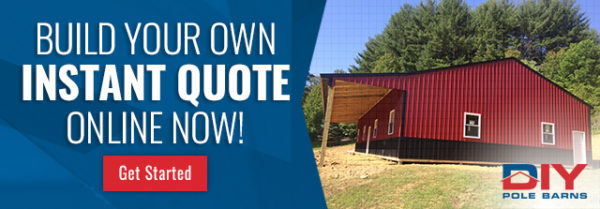Air flow and quality can have a dramatic impact on your investment – the investment in the pole barn itself as well as the goods and/or livestock kept in it. The flow of air affects the relative humidity and temperature inside your pole barn which, in turn, has an effect on the air quality. Pole barn vents are extremely helpful in regulating airflow.
Why Is Pole Barn Air Quality Important?
Depending on the intended use of your pole barn, air quality may not be a major factor for you. If you are building a pole barn for a garage or storage, the airflow will not have a great impact. Although, poor air quality can increase the possibility of rust or damaged goods even in general storage situations.
When you plan to use your pole barn for other purposes like workshops, animal barns or horse stalls, poor air quality can lead to health issues. Pole barn vents help regulate the airflow and increase the quality of air. Where animals are involved it’s especially important to maintain healthy environments to avoid long-term respiratory issues or general discomfort.
Pole Barn Vents to Help Manage Your Pole Barn
When you have sufficient pole barn venting, you will enhance the air quality and comfort of your pole barn. Proper pole barn venting simultaneously prevents some minor issues like mold by reducing the general moisture inside.
One addition that you can establish with your DIY Pole Barns quote is a continuous ridge vent. The gap at the top of the roof caused by the rib pattern of the metal roofing is sealed with breathable strips which contour to the ribs. This continuous ridge vent will aid in overall ventilation and the reduction of condensation. If you plan to build a ceiling on the interior or for pole barns being designed for livestock, these ridge vents are a necessity.
Another way to assist in air circulation is to add cupolas to your pole barn design. Not only are they useful in improving air quality, they add a visually appealing element to your pole barn.
Powered Pole Barn Ventilation Can Help
There is also the option for powered pole barn ventilation. This may be something you want to investigate when building your pole barn. It is a more expensive option to add powered pole barn vents, however the investment means you will have more control. This can allow you to create an ideal environment for animals or improved air quality for a hobby shop.
Pole barns offer a lot of potential for customization. Fans can be installed and wired to operate on timing controls, humidity sensors, or even thermostats, and are just one way powered venting puts air quality control directly in your hands.
Other Tips for Pole Barn Venting & Air Quality
Plan for More Doors or Windows
More access to air means increased airflow. Installing larger doors and additional windows is another way to help increase or decrease airflow as needed. These additional openings provide new direct paths for air to flow in and out of your pole barn. In addition to pole barn vents, these doors and windows will minimize the stale air inside. When you have cold or windy weather, simply close a few extra windows to regulate the airflow and temperature.
High-Pitched Roof
When you incorporate a high-pitched roof for your pole barn, it helps to exhaust stale air and allow fresher air to come in. Steeper roofs also help shed snow, which keeps that additional moisture farther away from the pole barn. Pairing sufficient pole barn vents with a high-pitched roof is a great way to help control air quality.
Let Overhangs Help Keep Humidity Down
Another way to improve the overall air quality is by incorporating overhangs in the design of your pole barn. Overhangs direct roof water further away from the structure and prevent rain and snow from landing directly along-side the pole barn. By directing the rain and snow away, moisture is prevented from building up due to snow resting along the perimeter of your barn or water pooling nearby, and excessive moisture in the air can be a huge detriment to air quality. When you pair overhangs directing water away and pole barn vents encouraging proper airflow, you get a one-two punch against excess moisture and poor air quality.
Plan Your Building Site Properly
When planning your building site, take the natural airflow into consideration. It is advantageous to build your pole barn where natural airflow can help push air in and out of your pole barn. This natural airflow will work in conjunction with your pole barn vents in regulating the air quality. In high-wind areas, poles can be seated deeper giving your pole barn more resilience to high winds.
You also want to look for potential windbreaks in the area and consider facing your pole barn in such a way that the natural airflow won’t be interrupted before it gets to the barn. When you plan and design your pole barn to incorporate and take advantage of the natural airflow, you’ll have much greater success with achieving good air quality than if you’d positioned your pole barn in such a way that the natural airflow was working against you.
Since air flow and quality impact the investment that you make in your pole barn, as well as what is kept inside it, considering all the factors that affect air quality is important.
Build Your Pole Barn – Get an Instant Quote Online!
If you’re ready to build your pole barn, lock in a quote with DIY Pole Barns using our Instant Quote tool! Have questions? Call our knowledgeable staff at (937) 547-9100.
Connect with us on social media!




